Metropolitan Museum of Art Nyflanders Workshop of Robert Campin
- Dwelling house
- Robert Campin
Robert Campin.
The Master of Flémalle.
Robert Campin is generally accepted (just not universally) equally the painter who was previously identified as "The Chief of Flémalle." Born c. 1380 Campin is considered to be ane of the beginning artists to depict realistic interpretations of his painted subjects.
Forth with his contemporary, Jan van Eyck, he was likewise among the first to experiment with oil paints.
Campin worked in the town of Tournai, on the southern edge of Flanders and became a citizen of that town in 1410. Information technology would appear that he held some civic role in Tournai just lost his post due to a scandal involving adultery and the keeping of a mistress.
These misdemeanours, in addition to his involvement in political disturbances inside the metropolis, resulted in Campin beingness exiled for a year. However, due to the intervention on his behalf of Countess Jacqueline of Hainault, his punishment was reduced to a fine.
In 1427 Campin took two apprentices into his workshop: Jacquelot Daret and Rogier van der Weyden (at this time Van der Weyden was known as Rogelet de le Pasture.)
The artistic styles of Robert Campin, Van der Weyden and Jan van Eyck are oft intertwined making the attribution of works to these artists difficult.
In particular distinguishing the paintings of Campin and Rogier withal manages to create contend among some scholars to this day.
The Mérode Altarpiece is a triptych whose three panels show, the donor and his wife, left console, The Annunciation, middle console, and St Joseph on the right panel. The mysterious effigy of the donor in the left wing wears the badge of the boondocks of Malines simply his identity is unknown.
The central panel is a depiction of a middle-class room in which the Declaration takes place. The settee which the Virgin leans against is typical of a style common in the netherlands but the room is filled with the religious symbolism associated with this outcome. The lilies in the vase symbolise Mary'southward virginity. The scroll and the book represent the Old and the New Testaments.
The room is lit by rays of sunlight at the top left of the painting, a miniature crucified Christ is carried on one of them and is about to enter the Virgin's body. The low-cal is focused on Mary'south clothes forming a star shape, a possible foretelling of the star of Bethlehem.
The right panel portrays St Joseph working every bit a carpenter, he has made a mousetrap evoking an idea by St Augustine that Satan is trapped and defeated in a claret-aside snare within the Passion of Christ.
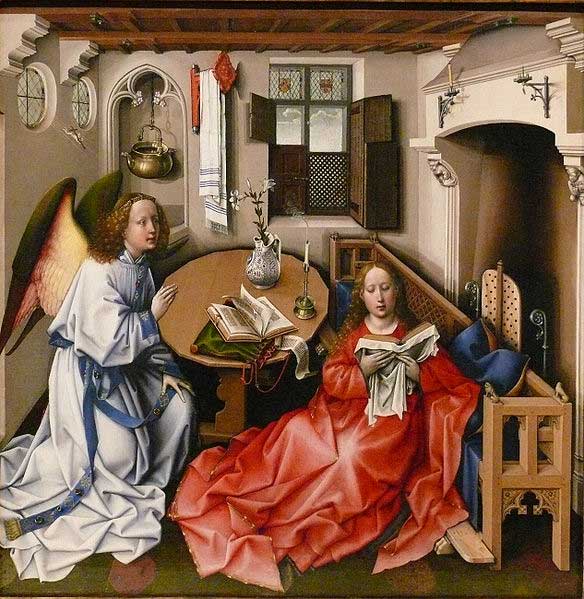 Mérode Altarpiece. (centre panel )
Mérode Altarpiece. (centre panel )
The "Virgin and Child before a Firescreen" as well known as the "Salting Madonna," (named after its final individual possessor, George Salting) is a view of the Virgin set within a typical Netherlandish household complete with a detailed Flemish vista through the open window.
This is a domestic scene, the Madonna is a well-fed female parent who is about to feed her child. She sits on a bench that is besides representative of a throne. The plated firescreen behind the Virgin'due south head provides a halo, this and the chalice close to her left arm are reminders of the religious bailiwick of the painting.
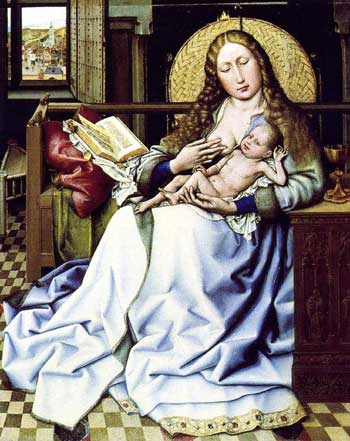 Robert Campin, "The Salting Madonna" c.1435, National Gallery London. (s)
Robert Campin, "The Salting Madonna" c.1435, National Gallery London. (s)
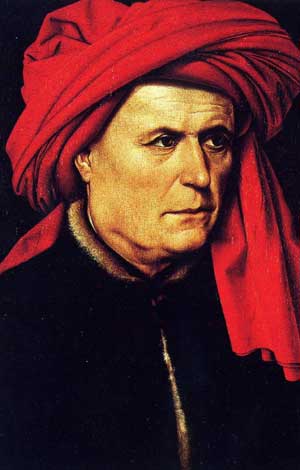 Portrait of a Man. c.1430. National Gallery London. (s)
Portrait of a Man. c.1430. National Gallery London. (s)
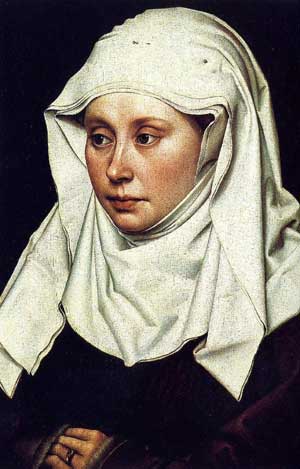 Portrait of a Woman. c.1430. National Gallery London. (south)
Portrait of a Woman. c.1430. National Gallery London. (south)
Robert Campin'southward portraits of a man and adult female are much more realistically defined than his figures in the Salting Madonna and the Merode Altarpiece. They are reminiscent of the work of Jan van Eyck.
These portraits highlight the artist's power to paint the earth equally he saw it His ability to catch the facial expression of the sitters (probably homo and wife) had never before been captured with such delicate grapheme.
Robert Campin'due south Werl Triptych.
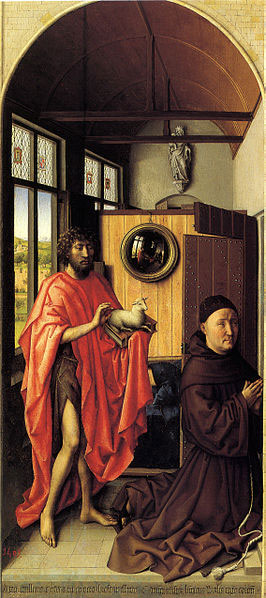 Werl Triptych (left-manus console) 1438. Prado, Madrid. (w)
Werl Triptych (left-manus console) 1438. Prado, Madrid. (w)
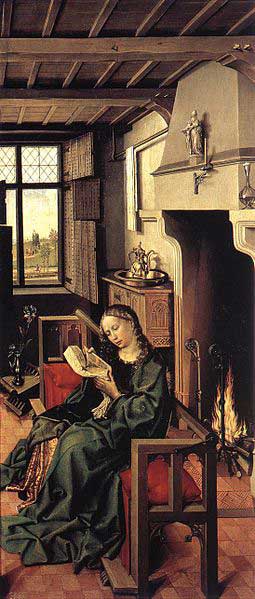 Werl Triptych (right panel) (w)
Werl Triptych (right panel) (w)
The centre panel of this Triptych has been lost. In the correct panel, St Barbara sits reading her book inside a middle-class room then typical of Campin. An open fire heats the room from behind the Saint who sits on a bench common in Campin's paintings.
St Barbara'south dark-green dress is in stark contrast to the crimson cushions on the bench, to a higher place the fireplace, a detailed sculpture of the Trinity can be seen.
The left panel features St John and the donor Heinrich von Werl who is placed prominently in forepart of St John. In a clear reference to the piece of work of van Eyck, a convex mirror reflects the scene back into the room.
Both panels feature windows that bear witness views of the landscape in the altitude.
Robert Campin died in Tourni on 26 Apr 1444.
Home Page.
Source: https://www.italian-renaissance-art.com/Robert-Campin.html
Postar um comentário for "Metropolitan Museum of Art Nyflanders Workshop of Robert Campin"